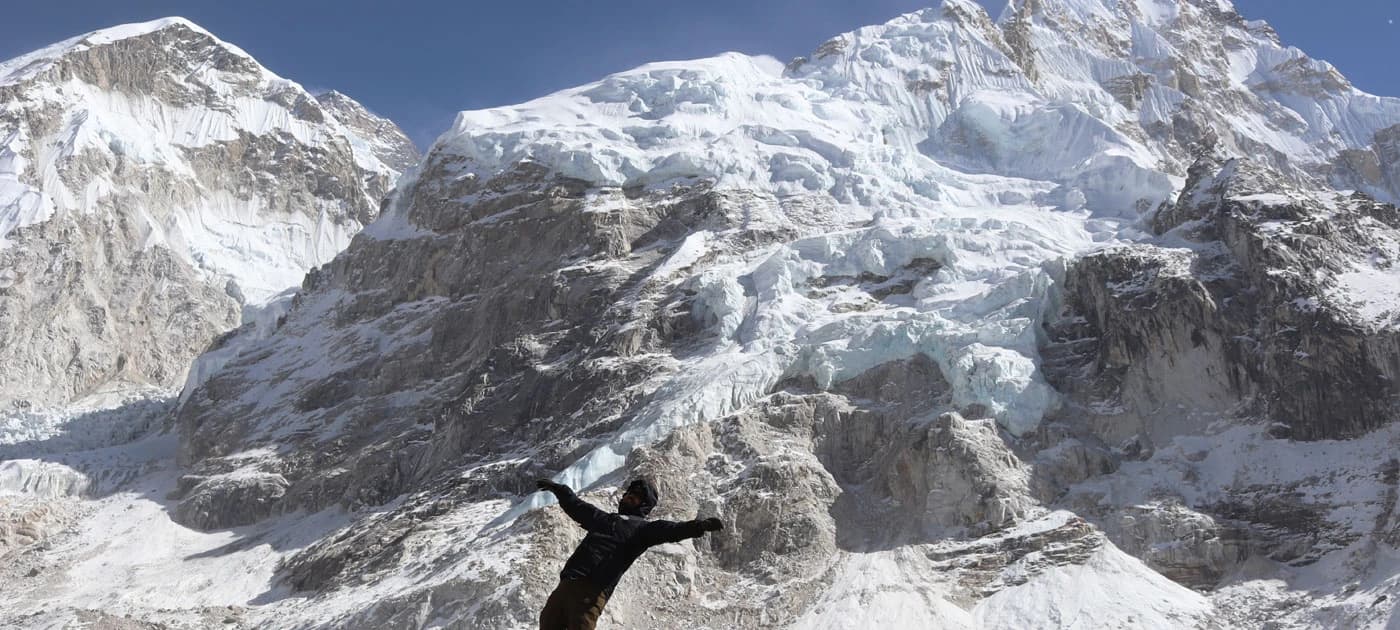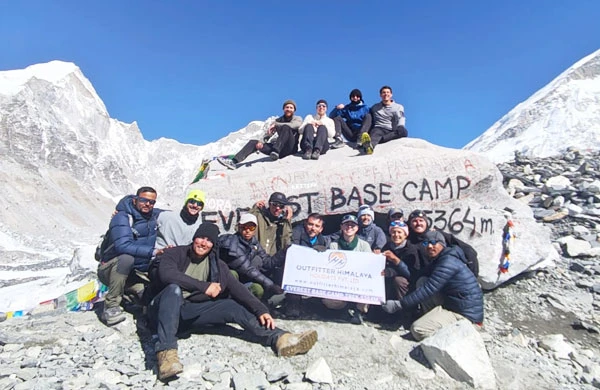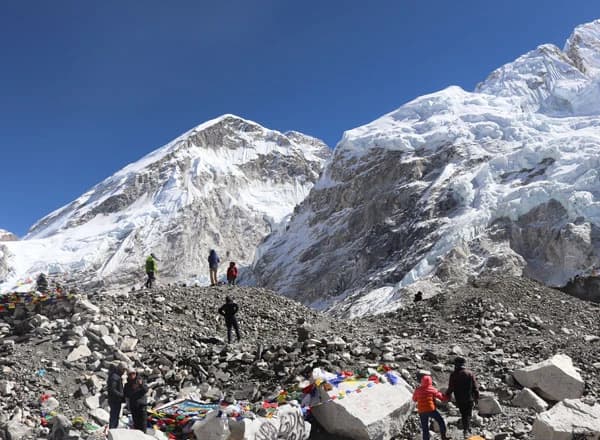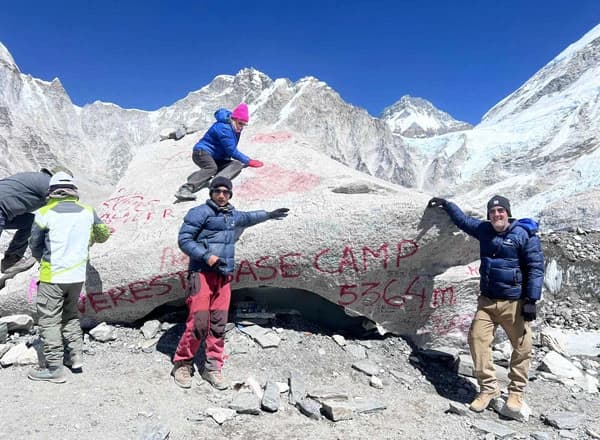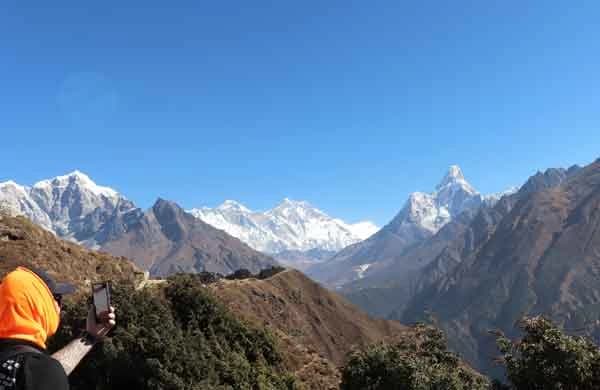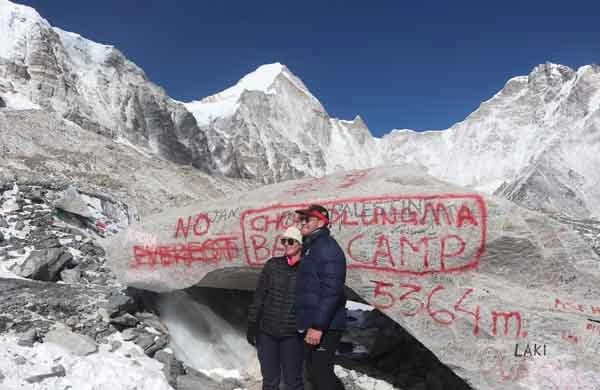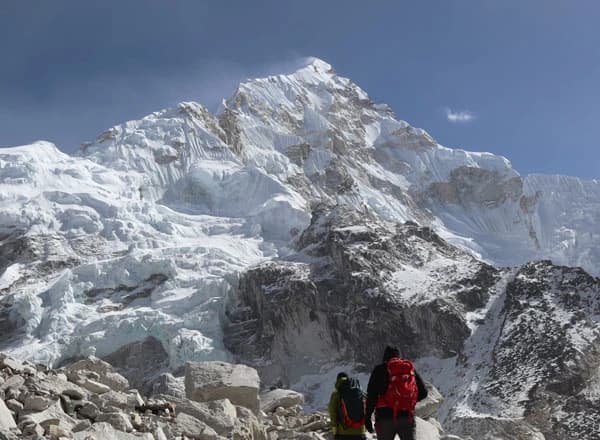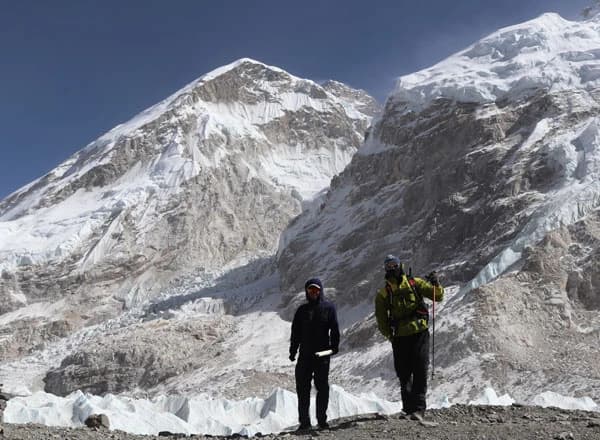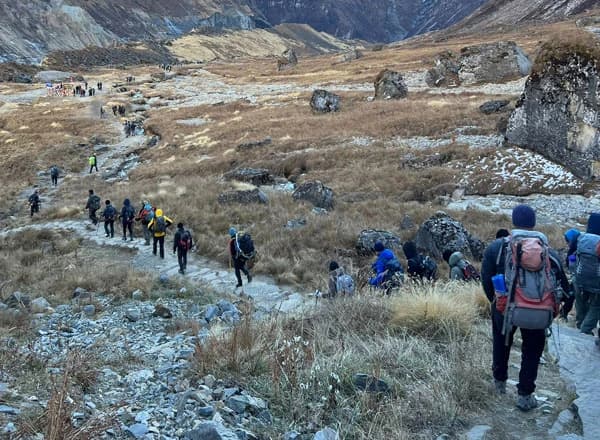Everest Base Camp Trek in July and August is not the best idea. July and August is the peak of the monsoon season in Nepal. Monsoons especially affect Lukla flights, making the trails slippery and muddy at lower altitudes. The weather is quite unstable in July and August, making trekking more challenging.
Everest Base Camp Trek In July and August 2026
Is it impossible to do the Everest Base Camp trek in July and August?
Well, no. It is not impossible to trek to Everest Base camp in July and August. Trekkers must only be well-prepared and have a few contingency days in their itinerary. The good news is that rainfall is not that heavy in the Everest region, and as you ascend higher, the climate becomes much more dry and cold, even in July and August.
You will most likely come across heavy rainfall in Kathmandu during the starting 1-2 days of trekking. Proper knowledge about the weather and climate will help you make smart decisions for the Everest Base Camp in July and August.
There are cons to trekking to EBC in July and August, as well as benefits you will not get in any other months. For instance, peaceful trails, discounts in Lukla flights and lodges, teeming greenery, etc.
This blog will discuss the pros and cons of trekking to Everest Base Camp in July and August. We will also discuss the challenges and offer solutions. Please read the blog fully.

Weather and temperature in July
July is Nepal's wettest and hottest month. If it does not rain, the scorching heat makes the climate uncomfortable. Even if it does rain, the climate is hot and humid.
In the mountains, once you go above 3,500 meters, the climate gets pleasant, but exposure to the sun is very high, and trekkers have to use high SPF frequently. Likewise, once you exceed 4,000 meters, the rainfall is low, and the climate remains dry and cold.
The temperature can reach 22°C during the day and drop to 4°C or 5°C at night. Note that this is the average temperature in the mountains. In places like Kathmandu and Pokhara, the temperature in July ranges from around 35°C to 40°C and gets higher in other cities in the Terai region (plains).
In July, the average high temperature in Lukla is around 22°C, and the average minimum temperature is around 12°C. Likewise, in Namche Bazaar, the temperature ranges between 8°C and 19 19°C.
As you go higher, the temperature will drop, especially at night; in the mornings, you will experience the lowest temperature. Mornings are usually clear, and rain mainly falls during the afternoon, evening, and night. On some days, rain may fall throughout the day. You never know.
Weather and temperature in August
August is a hot and humid month. It is the peak of summer/monsoon season in Nepal, and the first two weeks are especially hot. Rainfall also increases throughout the country, ruining most highways connecting major cities.
However, you do not have to worry about highway conditions during the EBC trek in August because you will fly in and out of Lukla and trek for the rest of the journey. The average temperature along the Everest Base Camp trail in August is 5°C to 15°C.
The temperature may drop below 5°C at night and in the morning. If it is not raining, the daytime is warm and comforting. The rainfall decreases once you gain good elevation, and the trails are mostly dry. Like in July, expect rainfall mainly during the afternoon, evening, and night.
If the weather remains gloomy, nights and mornings can get cold. The average wind speed this month is 16 km/hr. However, not all days will be gloomy and pouring, so you will enjoy a fair share of bright and sunny days. Find the details of the monthly weather and temperature of the Everest Base camp trek.
Everest Base Camp Trek in July and August: Advantages
Trekking in July and August also has perks you will not get in other months. Below, we have shared the perks of the Everest Base Camp trek in July and August:
No crowd
There is no crowd on the Everest Base Camp trek route in July and August. You will rarely come across other trekkers in these months. July and August are known as the off-season for the EBC trek, so only a few travelers embark on this trek in these months.
Trekkers looking for a peaceful trail and solitude will have a perfect time. You will have the entire trail to yourself. On the contrary, if you enjoy others' company and want to make new friends worldwide, you may be disappointed.
Off-season discounts and offers
The low demand in July and August lowers the price of everything. Even the friendly hotels in Kathmandu and luxury lodges along the EBC trail are available at discounted prices. It will not make a huge difference in price, but we all love discounts and offers.
Lukla's flight rates go down. You can take the Lukla flights from Kathmandu airport instead of driving for 5 hours to Ramechhap Airport for the flight. Similarly, all the services, like charging, hot shower, WiFi, etc, in the lodges cost less in July and August.
Full attention from the locals
Because very few trekkers visit the Everest base camp in July and August, they get full attention from the villagers and lodge staff. The interactions are very intimate. You will have a lot of opportunities to share long conversations and ask your queries.
The lodges are cleaner and peaceful. You will be served freshly cooked food. Likewise, you may also get to try unique dishes off the menu that are in season. In Kathmandu, you will also have the full attention of the locals.
The soothing monsoon mist and clouds
Monsoon clouds and showers obstruct mountain views and create unbelievably gorgeous scenery. Cloudy skies are not always bad. Sometimes, they make the most mesmerizing view. Rainfall cleans the air, making the environment fresh and rejuvenating.
Earthy scents cover the entire trail. You will be much more relaxed. Instead of annoyance, see the clouds and rainfall as the beauty of nature. It is all in your perspective.
Festivals
Every month in Nepal, there are big or small festivals. In July and August, locals celebrate festivals like Naag Panchami, Janaipurnima, Gai Jatra, Krishna Janmashtami, Teej, and Rishi Panchami.
Some of them, like Janaipurnima, Gai Jatra, Krishna Janmashtami, and Teej, are major festivals for the Nepalese people. You can schedule your trek to enjoy the festivals closely. Even if you don't, the festive vibe will enhance your trip to Nepal.
Everest Base Camp Trek in July and August: Challenges.
July and August are the off-season for walking to Everest Base Camp. If you have ever read anywhere that trekking to Everest Base Camp Trek in July and August is not challenging, then it's false.
This trek is difficult even during the peak trekking seasons, and additional weather challenges are expected during the off-season. Though the journey is a bit more demanding in July and August, it is also navigable and requires extra attention and preparation.
Below, we have shared the challenges of the Everest Base Camp trek in July and August with solutions:
Heavy rain and slippery trails
Heavy rain and slippery trails are one of the biggest challenges of July and August. The trails at lower altitudes are mostly affected by heavy rain. They get muddy and slippery. Likewise, rainfall increases bugs and leeches on the trail. Insect repellent is essential; trekkers must wear full pants and rain boots.
Even with trekking poles, walking becomes difficult, requiring more strength and effort. Trekkers also have to be very careful while navigating steep tracks. The trail from Lukla to Phakding and Phakding to Namche Bazaar is affected mainly by heavy rainfall.
Lukla flight delays and cancellations
We all know that Lukla flights are crucial to the Everest Base Camp trek. Flying to Lukla is not like flying to other airports. This airport's high elevation and small runway require perfect weather for a safe take-off and landing. So, even slight weather adversity may delay the flight.
In July and August, the morning Lukla flights are mostly on schedule; however, clouds kick in as the climate warms up, increasing the chances of rainfall. On some days, rainfall may also disturb morning flights.
Trekkers must have at least a few contingency days in their Everest Base Camp trek itinerary during July and August. Even if your Lukla flight is delayed, contingency allows you not to panic and enjoy the trip.
Obstructed mountain views
The visibility is low in July and August because of clouds. The mornings are clear, but dense clouds may block the mountain views by afternoons. Likewise, gloomy days will also affect the beauty of the landscapes.
Not every day will be like this, but trekkers should understand that they may not enjoy the scenery from all viewpoints. Trekkers whose priority is to capture the beauty of the Everest region should consider trekking in July and August.
Acclimatization challenges
Acclimatization is an essential part of trekking to Everest Base Camp. Trekking may become more physically and mentally challenging if you do not like rain. It will affect your acclimatization and make you more prone to altitude sickness.
The solution is to embrace the rain, its soothing scent, and its calming sound. Likewise, improve your strength and stamina before starting the trek and gain some high-altitude experience by doing day hikes in your country.
Limited accommodation and services
Due to heavy rainfall, some lodges may get closed along the Everest Base Camp route. Very few tourists do EBC trek in July and August, so the region and the lodges are almost empty. So, even if some lodges get closed, you will not have difficulty finding a place to spend the night.
Likewise, services such as WiFi, mobile networks, and electricity may be lacking in these months. Most villagers rely on solar power in the Everest region. On gloomy days, the solar panels do not charge, so you may be unable to charge your devices.
So, extra batteries and a power bank are highly recommended. Likewise, the network may not always be there due to unstable weather and rain. Let your family know where you are and where you are heading next. Let them know you may get off the grid for a few days, but it will be fine because you are traveling with a professional guide.
Rise in insects and leech activities
As mentioned above, during the monsoon season, the trails are covered with insects and leeches. The lower altitudes are especially affected. It is not dangerous, but it may be annoying and scary for those who hate insects and leeches. Wear appropriate clothes and rain boots. Cover your ankles and use insect repellent.

Is July and August the right time for Everest Base Camp Trek
Whether July and August are right for trekking at Everest Base Camp depends on your requirements and interests. If you have a vacation in these months and want to trek to EBC, go ahead.
Likewise, travelers interested in biodiversity and would love to discover the rich flora and fauna of the Sagarmatha National Park would also enjoy trekking in July and August. Similarly, individuals looking for the best Everest Base Camp trek deals will have a fantastic choice.
Ask yourself what you are looking for and what you are ready to adjust. Acknowledge the limitations and challenges of July and August, and you are more likely to have a life-changing trip.
Note that trekking in the Himalayas during off-time, like July and August, will give you a different perspective than most trekkers. You will see the unconventional beauty of the Everest region, which can be a great experience for some and unsatisfying for others.
Do weigh your options and requirements before choosing the month.

Can a beginner attend the Everest Base Camp trek in July and August
The Everest Base Camp trek is generally considered quite a challenge for beginner trekkers. Doing it during the off-season, when weather and climate are not preferable, increases the difficulties and makes the trek more demanding.
Are beginner trekkers recommended to do the EBC trek in July and August
The answer depends on your endurance and perseverance. The most significant requirement of the Everest Base Camp trek in July and August is dealing with muddy tracks, leeches, and rainfall. If you are OK with these things, you will have a lovely hike to the base of the tallest mountain in the world.
Do not trek alone in July and August. First of all, it is unsafe, and second of all, you will get extremely bored because there are usually no other trekkers to provide you with company. Trekking with a local agency will ensure your comfort and safety during the off-season trekking.
You will have a better experience. If you are a beginner trekker and planning to do the Everest Base Camp trekking in July or August, ensure you are physically and mentally ready for the journey. Improve your strength and stamina.
Everest Base Camp Trek in July and August: Tips
While trekking in July and August, travelers must be extra careful and follow a few additional rules. We have led many trekkers to Everest Base Camp duringjuly and August, so all the tips shared below are purely from our expertise and will significantly help you.
- Read and thoroughly understand the weather during your trek. Though the weather in the Himalayas is unpredictable and changes frequently, having even a surface idea will help you a lot. Likewise, stay updated with daily weather reports.
- Trust your guide's instinct. Our guides are highly trained and explain everything in detail. They understand how weather works in the Himalayas and can predict rainfall. Listen to their advice.
- Follow your guide's lead and stay on the marked trail. Tracks can become slippery after rain, so make sure your trekking boots have good traction. Walk slowly and be attentive to your guide's instructions. The guide will help you navigate steep, slippery trails.
- Carry insect repellent to prevent mosquitoes and other bugs from biting you. Likewise, the anti-leech spray will be very handy. Wear full pants and T-shirts when walking.
- The afternoon can get cloudy or gloomy, so we highly recommend trekking as early as possible. This way, you will be able to avoid later afternoon showers and also not miss beautiful landscapes.
- Plan for the evening. Pack travelers' games, books, and snacks. Spend time with locals and other trekkers (if you come across any). Enjoy free time, relishing the rainfall sound and scent.
- Plan at least 3-4 contingency days in your itinerary. It will help you reschedule your Lukla flight if it is canceled due to bad weather.

Everest Base Camp Trek in July and August: Accommodation and food
The Everest Base Camp route remains empty in July and August, so the lodges are empty, too. Some lodges may close due to heavy rain, but most are open. You will have no issue finding the best rooms. Additionally, the prices are also down because of less demand.
Nights and mornings are colder than the daytime. You may need an additional blanket to stay warm throughout the trek. Feel free to ask the lodge owner. Likewise, you can also carry a sleeping bag for more comfort. Nice hotels are also available at discounted prices in Kathmandu.
Food availability is also excellent on the EBC trail in July and August. However, some dishes on the menu may not be available because lodges are not stocked with all ingredients during the off-season. Still, the available options will be more than enough. Additionally, you may enjoy special seasonal dishes that are not on the menu.
Everest Base Camp Trek in July and August: Network and WiFi
Due to fluctuating weather, mobile and WiFi networks are unreliable in the Everest region in July and August. The network is not great on the Everest Base Camp route, even during the peak trekking seasons. Heavy rainfall in July and August affects whatever network is available.
We recommend that trekkers prepare their minds to go off-grid during trekking and inform their loved ones. You will be trekking with one of our expert guides, so there is nothing to worry about.
Everest Base Camp Trek in July and August: Some FAQs and Answers
Frequently asked questions regarding the EBC trek in July and August.
What kind of weather should I expect on the EBC trail in July and August?
The Everest Base Camp trail weather in July and August is volatile. Daytime is hot and humid with frequent rainfalls. Nights and mornings are comparatively cooler. The higher altitude receives less rain and is colder than villages at lower elevations like Lukla and Phakding.
Will there be risks of landslides or floods on the trail?
The Everest Base Camp trek route is well made, so there is very little risk of landslide and no flood risk. We do not see landslides on the EBC route. It is a rare scenario.
How muddy and slippery will the EBC path be in July and August?
Due to frequent heavy rain, the trail between Lukla and Dingboche is muddy and slippery. You have to walk with extra care and attention.
How can I stay dry and warm during the EBC Trek in July and August?
To keep yourself dry during rainfall, wear proper rain gear, such as a rain cover, waterproof back, and rain poncho. Likewise, wear clothes in layers and pack warm outer layers.
Which trekking boots provide the best grip for wet and slippery EBC trails in July and August?
The best trekking boot for wet and slippery trails should have deep, multidirectional lugs. These provide a superior grip and keep you stable. For instance, Vibram soles or similar high-traction rubber outsoles are highly recommended. Also, pack the one with a high-ankle design for extra support.
How many sets of clothes should I pack for a monsoon EBC trek?
It depends on your itinerary. We suggest packing ample clothes to last your whole trip. Do not rely on washing and reusing the clothes. Carry dry bags with you to store used clothes.
How can I protect my electronics and important documents from rain?
Bring rain protection gear for your electronic devices and documents. For extra protection, keep these things inside a plastic or ziplock bag.
How reliable are flights to Lukla during monsoon season?
Due to unstable weather conditions, the Lukla flights experience frequent delays and cancellations in July and August. Therefore, trekkers are recommended to include at least two extra days in their itinerary.
Should I take a helicopter flight or trek from Salleri/Phaplu instead?
Trekking from Salleri or Phaplu from July to August is not recommended unless you love rain and all its associated factors. Starting your EBC trek from these places means you will spend an additional few days trekking in lower altitudes, which can be quite exhausting in monsoon season.
Helicopter flights have a better operational rate than commercial Lukla flights and are less likely to be canceled. Even if the flight is canceled, it can fly as soon as the rain stops, giving you much more flexibility.
Are tea houses open in the EBC trek and operating during monsoon season?
Most tea houses along the Everest Base Camp trail operate generally during the monsoon season. Even though there are no trekkers, the tea houses remain open.
Do I need to pre-book my accommodation, or will there be enough availability?
You do not need to pre-book your accommodation in July and August. Lodges remain empty during these months because the region has few trekkers.
Are leeches a problem on the lower parts of the EBC trail in Monsoon? If so, how do I prevent leech bites?
Yes, leeches are a problem on the lower parts of the EBC trail. To prevent leech bites, carry anti-leech spray and wear long trousers and t-shirts.
Do I need a guide and porter for the Everest base camp trek in Monsoon?
Yes, you need a guide and porter during the monsoon season. The Monsoon makes the Everest Base Camp trek more challenging and requires the guidance of a professional guide who can help you navigate steep, muddy sections safely.
Will I still get good mountain views, or will clouds block visibility in Monsoon on EBC Trek?
It depends on your luck. The good thing is mornings are mostly clear, so if you start trekking early, you can see outstanding mountain vistas and landscapes.
How much should I budget for an EBC trek in July/August?
Your expenses will be less on the Everest Base Camp trek in July and August compared to the peak trekking months. We, Outfitter Himalaya, provide special discounts for our off-season treks.
Likewise, the charges for extra services in the lodges are also lower this month. For instance, you will be OK with a daily budget of USD 10 - 15 for personal expenses.
Is there a risk of snowfall in EBC Trek at higher altitudes, even during monsoon season?
Snow may fall at higher altitudes if the weather gets very bad. However, it will not be as intense as the winter season.
Should I bring extra shoes or sandals for EBC Trek in July and August?
Bringing extra shoes or sandals into the teahouse is a good idea. Light shoes will give you better flexibility when you are not trekking.
Are there alternative trekking routes to avoid Lukla flight cancellations in Monsoon?
The best alternative to avoiding Lukla's flight cancellations in July and August is to opt for helicopter flights. Helicopter flights are less likely to be canceled and are much more comfortable.
Should I carry antifungal creams for foot and skin infections?
The EBC trail goes through lush forests. You will be exposed to various plant species, rainfall, and insects. If your skin is sensitive, kindly meet with your doctor and get skin allergy medicine prescribed for the journey.
What are some good ways to stay motivated if the weather is gloomy?
Start trekking early and embrace the beauty of gloomy days. Joke around with your group and relish the views. Listen to songs or podcasts. Have fun, and you will stay motivated.
Final Say
I hope you have found the above information regarding the Everest Base Camp Trek in July and August helpful. We have selected some of the best treks in Nepal for the Monsoon season. Compare all the treks and plan your trek in Nepal for July and August.
- Everest Base Camp Trek in January
- Everest Base Camp Trek in February
- Everest Base Camp Trek in March
- Everest Base camp Trek in April
- Everest Base Camp trek in May
- Everest Base Camp Trek in June
- Everest Base camp Trek in September
- Everest Base Camp Trek in October
- Everest Base Camp Trek in November
- Everest Base Camp trek in December
Is an Everest Base Camp Trek in February possible? Yes, it is, and it is enjoyable. Given this month's poor reputation for unstable weather and a cold climate, February sounds like a very odd time [...]
Start the New Year with a challenge of a lifetime that will shape you to become the most excellent version of yourself. Join us for the Everest Base Camp Trek in January and get guided [...]
It is undoubtedly possible to trek in Nepal during the winter season, which lasts from December to February. December starts the winter season, and February ends it. So, trekking in Nepal in December and February [...]
